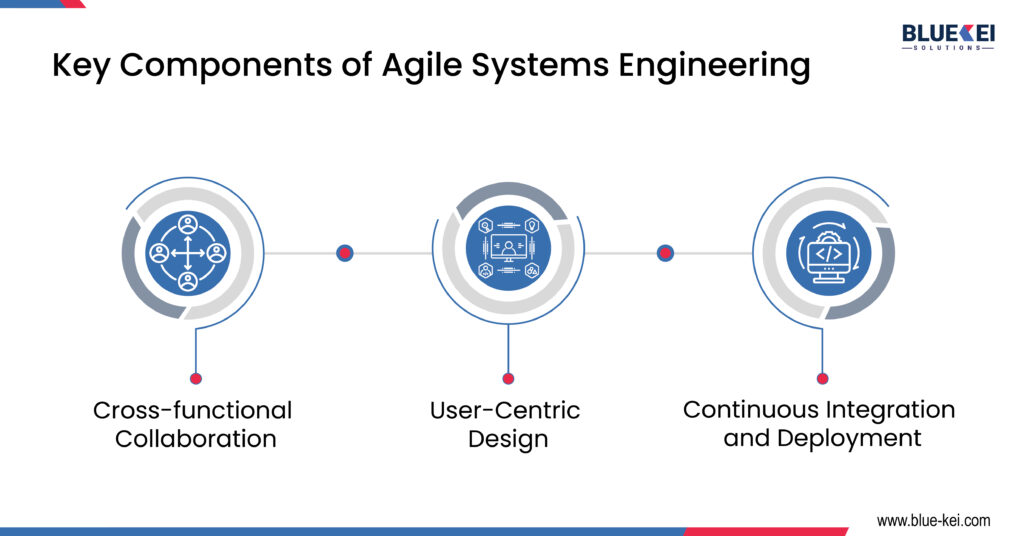Agile Systems Engineering: Adapting to Technological Advancements
In this age of rapid technological development, systems engineering is going through a significant transition. The modern need for agility, adaptability, and fast change response puts established methods to the test. In-depth discussion of Agile Systems Engineering (ASE) and its critical role in assisting readers in navigating the intricacies of contemporary technological innovation are provided in this blog article. There is additional discussion of ASE’s guiding principles and processes.

Unraveling the Agile Paradigm
From Waterfall to Agile: Tracing the Evolution of Systems Engineering Methodologies
The shift from Waterfall to Agile in systems engineering marks a major transformation. The Waterfall vs Agile method can be characterized as follows: Waterfall’s linear approach, requiring substantial upfront planning, resulted in long cycles and limited adaptability. However, agile places a strong emphasis on teamwork, iterative development, and ongoing feedback to help teams adapt quickly, reduce risks, and provide incremental value. A dynamic, customer-centric strategy replaces inflexible methods, and this progression facilitates that shift—which is vital in today’s technologically advanced, fast-paced industry.
Principles of Agile Systems Engineering: Embracing Change, Iterative Development, and Customer Collaboration
The Agile paradigm represents a radical shift from previous approaches in systems engineering by emphasizing flexibility, teamwork, and iterative development. In order to adapt to changing requirements, Agile Systems Engineering departs from strict planning and accepts change with ease. Iterative development through brief cycles (sprints) is essential to ASE since it allows for quick reaction to changes in the market. In order to ensure that goods live up to expectations and provide the most value possible, it places a high priority on customer involvement throughout the lifetime. Essentially, ASE enables businesses to successfully negotiate complicated situations with agility, promoting creativity in ever-changing contexts.
Scalability and Flexibility: Adapting Agile Practices to Diverse Projects and Environments
Unlike rigid methodologies, Agile frameworks such as Scrum and Kanban offer versatility, tailored to meet specific project needs regardless of size or complexity. Agile teams organize work through practices such as sprint planning and daily stand-ups, providing a flexible structure that is scalable to project demands. Emphasizing collaboration and continuous improvement, Agile fosters adaptability and resilience, conducive to thriving in dynamic settings. Whether in software development, product management, or non-technical fields such as marketing or HR, Agile offers a customizable approach to meet unique project requirements effectively.
The Dynamics of Technological Advancements
Agile Systems Engineering faces opportunities as well as challenges as a result of the increasing speed of technology innovation. It becomes imperative to integrate various technologies, promoting multidisciplinary cooperation for all-encompassing solutions. However, resolving incompatibilities and reconciling disparate approaches become obstacles. Risk management is essential in this ever-changing world. Agile methodologies mitigate risks and promote innovation by promoting experimentation and adaptation based on real-time feedback, embracing uncertainty through iterative prototyping. Thus, Agile Systems Engineering navigates technological complexities by leveraging collaboration, risk management, and iterative development.
Key Components of Agile Systems Engineering:
Cross-functional Collaboration (Fostering Communication and Collaboration Across Teams and Disciplines) | The smooth collaboration of several teams and disciplines is essential to the success of agile systems engineering. Organizations may eliminate silos and guarantee stakeholder alignment by fostering a culture of open communication, respect, and common objectives. This cooperative method improves creativity, problem-solving, and the timely delivery of high-quality systems. |

Challenges and Opportunities Ahead:
Cultural Shift: Overcoming Resistance to Change and Embracing Agile Mindsets Across Organizations
Fostering a culture that embraces experimenting and learning from mistakes is essential to overcoming resistance to change. This requires striking a fine balance between empathy and strategic communication. Adopting new techniques is only one aspect of adopting agile attitudes; another is developing a mindset that emphasizes flexibility, teamwork, and ongoing development. This change presents a chance to release latent creativity, improve adaptability to market conditions, and cultivate a more robust and creative organizational culture that is well-positioned for success in a constantly changing environment.
Regulatory Compliance: Navigating Regulatory Frameworks in Agile Environments
Agile approaches place a strong emphasis on flexibility and quick iterations, frequently undermining conventional compliance procedures that are defined by inflexible procedures and documentation. Clear communication, cross-functional cooperation, and iterative feedback loops are essential for successfully incorporating regulatory compliance into agile workflows. Teams must constantly evaluate the criteria set forth by regulations, plan compliance work into sprints, and use automation to expedite procedures without compromising adherence to industry and legal norms. Stakeholder involvement, continual education, and regular audits guarantee compliance with changing requirements while preserving the flexibility required for creativity and adaptability in today’s fast-paced corporate environment.
Ethical Considerations: Balancing Innovation with Responsibility in Agile Systems Engineering
Agile Systems Engineering requires careful balancing of responsibility and innovation, and ethical issues are crucial to this process. Agile methods encourage quick creation and iteration, but in order to guarantee that innovation advances society without jeopardizing equality, safety, or privacy, practitioners must constantly enforce ethical norms. This necessitates taking a proactive stance in recognizing and resolving moral conundrums at every stage of the development process, using the values of openness, responsibility, and stakeholder involvement to promote a responsible innovation culture.
The Future Landscape of Agile Systems Engineering:
With the integration of AI and machine learning, Agile Systems Engineering will witness revolutionary advancements that will boost productivity and flexibility. Concurrently, decentralized systems and blockchain will transform data management and cooperation while guaranteeing security and transparency. Development cycles will proceed with never-before-seen speed and dependability thanks to these innovations, which will also improve trust, expedite coordination, and strengthen the foundations of agile approaches.
Furthermore, cybersecurity resilience becomes a critical issue in agile systems engineering as the digital ecosystem grows increasingly interconnected. In order to protect sensitive data, prevent new attacks, and maintain the integrity of software ecosystems, teams need to proactively improve their procedures. Strong security measures, like threat modeling, vulnerability assessments, and secure coding practices, can be incorporated into agile workflows to help organizations strengthen their defenses, find vulnerabilities ahead of time, and foster a cyber hygiene culture. This will protect agile systems’ dependability and longevity in a constantly changing threat landscape.
We saw how businesses benefit from the systems engineering approach. There is much to explore and achieve. You may also want to reap the benefits of this approach. Let BlueKei help your organization leverage systems engineering to its full potential. Contact us to schedule a call to get things going!
If you are interested in understanding how to adopt systems engineering and model based systems engineering practices within your organization, reach out to BlueKei Solutions team at info@Blue-Kei.com. We specialize in systems engineering consulting, project executions, process adoptions such as compliance to ISO15288, ARP 4754A, ISO 42020, digital transformations. We can also conduct capability development workshops which are experiential and tailored to your needs. With systems engineering adoption you can address the complexity, manage evolving risks and bring transformation in communication within your organization through digitalization and create the digital thread.

